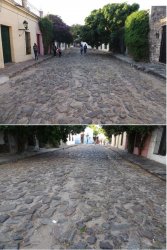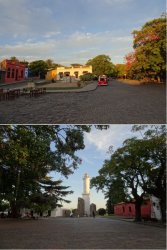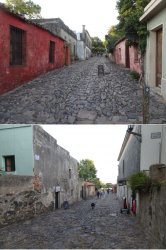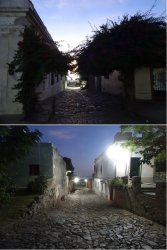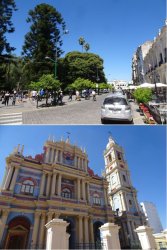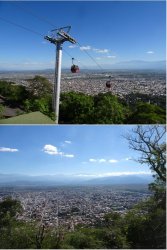You are using an out of date browser. It may not display this or other websites correctly.
You should upgrade or use an alternative browser.
You should upgrade or use an alternative browser.
A Chile chill with a Uruguay and Argentina topping
- Thread starter JohnM
- Start date
- Status
- Not open for further replies.
JohnM
Enthusiast
- Joined
- Jun 7, 2006
- Posts
- 11,812
- Qantas
- LT Gold
Next item on the agenda was a few days further north. The primary objective was to visit La Silla, the original European Southern Observatory site. It was to work there that @juddles’ father moved the family to Chile when @juddles was a kid – which was the last time he’d been up to the observatory – for Christmas. Great reminiscences!
The observatory is at 2400m and operates two major optical telescopes: a 3.6m telescope and the NTT (New Technology Telescope). The site also hosts some other nations’ telescopes (ESO - La Silla Facilities).
Ironically, it was a very cloudy day and there were even a few spots of rain as we waited at the entrance station to join the visit.
On the drive along Ruta 5, the Panamericana Highway - a typically excellent Chilean highway.

That’s the observatory on top of the mountain at the right. Massive solar installation gasping for sunlight that day.

The 3.6m in the conventional domed building. The NTT is in the new-style large non-domed building.

The 3.6m.

The NTT. Its mirror is a pioneering active optical type of unitary construction to compensate for atmospheric disturbance, not the active multi-element construction used in the latest optical instruments.


It had a detector on each side, each sensitive to different wavelengths.

Another view of the site and inside the control room. A very interesting visit.

The observatory is at 2400m and operates two major optical telescopes: a 3.6m telescope and the NTT (New Technology Telescope). The site also hosts some other nations’ telescopes (ESO - La Silla Facilities).
Ironically, it was a very cloudy day and there were even a few spots of rain as we waited at the entrance station to join the visit.
On the drive along Ruta 5, the Panamericana Highway - a typically excellent Chilean highway.

That’s the observatory on top of the mountain at the right. Massive solar installation gasping for sunlight that day.

The 3.6m in the conventional domed building. The NTT is in the new-style large non-domed building.

The 3.6m.

The NTT. Its mirror is a pioneering active optical type of unitary construction to compensate for atmospheric disturbance, not the active multi-element construction used in the latest optical instruments.


It had a detector on each side, each sensitive to different wavelengths.

Another view of the site and inside the control room. A very interesting visit.

JohnM
Enthusiast
- Joined
- Jun 7, 2006
- Posts
- 11,812
- Qantas
- LT Gold
That night, we stayed on the coast at a town called Huasco. A holiday place, but very quiet. After dinner, we stopped at a bar/café for a drink and were amazed to find the owner/singer was an Australian. We lingered until quite late chatting with her. Lovely lady.
Next day was a bit more exploring along the coast as we headed back south. A very pleasant village called Punta de Choros. A large island not far offshore is National Park and Humboldt penguin sanctuary.
Foxes were common because of being fed at a stop along the road back to the highway.


That day also finally saw the end of the constantly cloudy days of my first week in Chile. Looking south with the hill behinds Guanaqueros at the centre. And a sunny backyard at chez @juddles.

The next day we tracked down the Dalbosco winery in the Limari Valley, about 1.5h drive away, after having a superb Syrah-Cabernet of theirs at a restaurant in the Elqui Valley. Harvest was in progress. Crates of Cabernet Sauvignon grapes.
They also made an excellent viognier that had one some prizes. It made for an excellent sundowner.

The next day and sunny in La Serena. The Cruz del Tercer Milenio can be seen centre right in the bottom pic. It’s big!

And that evening we slipped down to @juddles’ friend’s restaurant for a couple of final pisco sours before heading back home for a final dinner with a Dalbosco Syrah/Cab Sauv and a Howard Park Leston Cab Sauv.
A fitting end to a great couple of weeks!

Next morning it was onto the bird LSC-SCL and hauling out of LSC. Then it was onwards to Buenos Aires that evening and onto the ferry next morning across to Colonia del Sacramento in Uruguay.

So ends the Chile chill. Thanks @juddles for a sensational time!
Now for some Uruguay topping.
Next day was a bit more exploring along the coast as we headed back south. A very pleasant village called Punta de Choros. A large island not far offshore is National Park and Humboldt penguin sanctuary.
Foxes were common because of being fed at a stop along the road back to the highway.


That day also finally saw the end of the constantly cloudy days of my first week in Chile. Looking south with the hill behinds Guanaqueros at the centre. And a sunny backyard at chez @juddles.

The next day we tracked down the Dalbosco winery in the Limari Valley, about 1.5h drive away, after having a superb Syrah-Cabernet of theirs at a restaurant in the Elqui Valley. Harvest was in progress. Crates of Cabernet Sauvignon grapes.
They also made an excellent viognier that had one some prizes. It made for an excellent sundowner.

The next day and sunny in La Serena. The Cruz del Tercer Milenio can be seen centre right in the bottom pic. It’s big!

And that evening we slipped down to @juddles’ friend’s restaurant for a couple of final pisco sours before heading back home for a final dinner with a Dalbosco Syrah/Cab Sauv and a Howard Park Leston Cab Sauv.
A fitting end to a great couple of weeks!

Next morning it was onto the bird LSC-SCL and hauling out of LSC. Then it was onwards to Buenos Aires that evening and onto the ferry next morning across to Colonia del Sacramento in Uruguay.

So ends the Chile chill. Thanks @juddles for a sensational time!
Now for some Uruguay topping.
craven morehead
Established Member
- Joined
- Aug 1, 2008
- Posts
- 2,742
- Qantas
- Platinum
- Virgin
- Gold
Looks like you lads had a great time 
JohnM
Enthusiast
- Joined
- Jun 7, 2006
- Posts
- 11,812
- Qantas
- LT Gold
Looks like you lads had a great time
We did, mate, we did
JohnM
Enthusiast
- Joined
- Jun 7, 2006
- Posts
- 11,812
- Qantas
- LT Gold
Ferry across the River Plate estuary departing from Buenos Aires to Colonia del Sacramento, Uruguay.

Colonia del Sacramento, and particularly its Barrio Historico on a small peninsula jutting into the River Plate, is a very picturesque UNESCO World Heritage site. It was, for me, by far and away the highlight of Uruguay. Otherwise, Uruguay, while a pleasant enough place, doesn’t offer a lot in the way of spectacular natural or man-made attractions.









Colonia del Sacramento, and particularly its Barrio Historico on a small peninsula jutting into the River Plate, is a very picturesque UNESCO World Heritage site. It was, for me, by far and away the highlight of Uruguay. Otherwise, Uruguay, while a pleasant enough place, doesn’t offer a lot in the way of spectacular natural or man-made attractions.








craven morehead
Established Member
- Joined
- Aug 1, 2008
- Posts
- 2,742
- Qantas
- Platinum
- Virgin
- Gold
Is the little yellow vehicle petrol or electric?
JohnM
Enthusiast
- Joined
- Jun 7, 2006
- Posts
- 11,812
- Qantas
- LT Gold
Is the little yellow vehicle petrol or electric?
That one was electric. There was a mixture among the many around town. That was a particularly small one.
For getting around the barrio historico, I didn't see much point in using one as it's not very large. On Saturday morning I went for a very long walk around the bay when one may have been useful, but I really enjoyed the walk on a beautiful day.
JohnM
Enthusiast
- Joined
- Jun 7, 2006
- Posts
- 11,812
- Qantas
- LT Gold
The next day it was picking up a rental car and heading east around the coast to Punta del Este, an upmarket holiday place. Rather Gold Coast-like. I passed through Montevideo, tracking along the coast but didn’t go downtown. Just another city.
I stopped at the naval museum, but time was getting on and it was very small and didn’t look all that interesting. It apparently has something on the scuttling of the German battleship Graf Spee just offshore in 1939 after it was damaged and boxed in by the British and a couple of days’ immunity in neutral Uruguay ran out, but nothing much, if anything, in the way of relics from it. It was easier to brush up on it from Wikipedia.
Punta del Este was nice enough, but soulless after Colonia and in the Gold Coast-like way. It’s on a narrow N-S orientated peninsula, the east side facing the Atlantic; the wets side facing the River Plate estuary (but this far east means that it is hardly evident as still the estuary). It does mean, though, a sunrise and a sunset coast less than a kilometre apart.

La Mano en la Arena (The Hand in the Sand) is a famed sculpture on the east-facing beach.

A couple of powered para-sailers cruised past at sunset.
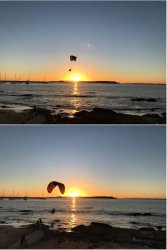

I stopped at the naval museum, but time was getting on and it was very small and didn’t look all that interesting. It apparently has something on the scuttling of the German battleship Graf Spee just offshore in 1939 after it was damaged and boxed in by the British and a couple of days’ immunity in neutral Uruguay ran out, but nothing much, if anything, in the way of relics from it. It was easier to brush up on it from Wikipedia.
Punta del Este was nice enough, but soulless after Colonia and in the Gold Coast-like way. It’s on a narrow N-S orientated peninsula, the east side facing the Atlantic; the wets side facing the River Plate estuary (but this far east means that it is hardly evident as still the estuary). It does mean, though, a sunrise and a sunset coast less than a kilometre apart.

La Mano en la Arena (The Hand in the Sand) is a famed sculpture on the east-facing beach.

A couple of powered para-sailers cruised past at sunset.


JohnM
Enthusiast
- Joined
- Jun 7, 2006
- Posts
- 11,812
- Qantas
- LT Gold
Leaving Punta del Este behind and heading inland, with a lot of Eucalypt plantations dominating the landscape. It appears that they ship a lot of whole stems as well as chips. The scale of operations is massive. There was a constant stream of log-hauling trucks on the inland roads.
Eucalypt plantation silviculture was interspersed with broadacre cropping, notably of soybeans and sorghum. These were coming to maturity and harvest was getting under way in many areas. All modern large-scale, high-efficiency agriculture.


It’s serious in Uruguay.

Swinging back towards Colonia del Sacramento through Fray Bentos on the upper reaches of the River Plate estuary – where it is the Rio Uruguay and a true river. A woodchip and wood log exporting port, but historically famous for being the site of the historic El Anglo meat-processing plant that exported massive amounts of beef to Britain and elsewhere in the early part of the 20th century – and was a very important meat supplier during WW2.
The old meatworks is a recently-proclaimed World Heritage site. It is especially famous for being the place where the famous Oxo beef cube originated.



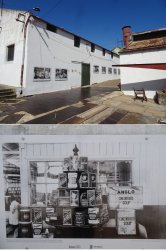

And then it was back to Colonia before high-tailing it over to Buenos Aires and its usual dreary Friday night street scene.

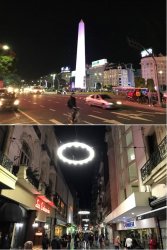
Eucalypt plantation silviculture was interspersed with broadacre cropping, notably of soybeans and sorghum. These were coming to maturity and harvest was getting under way in many areas. All modern large-scale, high-efficiency agriculture.


It’s serious in Uruguay.

Swinging back towards Colonia del Sacramento through Fray Bentos on the upper reaches of the River Plate estuary – where it is the Rio Uruguay and a true river. A woodchip and wood log exporting port, but historically famous for being the site of the historic El Anglo meat-processing plant that exported massive amounts of beef to Britain and elsewhere in the early part of the 20th century – and was a very important meat supplier during WW2.
The old meatworks is a recently-proclaimed World Heritage site. It is especially famous for being the place where the famous Oxo beef cube originated.





And then it was back to Colonia before high-tailing it over to Buenos Aires and its usual dreary Friday night street scene.


juddles
Suspended
- Joined
- Aug 2, 2011
- Posts
- 5,283
- Qantas
- Platinum 1
.
I can’t recall the name of this organism that grew in large clusters and which the fishermen harvesting it cut away to collect the flesh, but @juddles can enlighten.
View attachment 162558
.
That stuff is called "piure" in Chile - I think in Aussie they call it cunjevoi??
Some strikingly/starkly beautiful photos - thanks.
Why thank you ozduck - I did not realize I was so photogenic!!
juddles
Suspended
- Joined
- Aug 2, 2011
- Posts
- 5,283
- Qantas
- Platinum 1
Why thank you ozduck - I did not realize I was so photogenic!!
This is @johnMs TR.. not the humour thread...
Careful tgh, you may fall in his trap. There is no such thing as a simple "TR" by @JohnM, aka "The Botanist", aka "Lucifer". This puppet master has had you all dancing......
JohnM
Enthusiast
- Joined
- Jun 7, 2006
- Posts
- 11,812
- Qantas
- LT Gold
Next day it was on the bird from Buenos Aires (AEP – the (mainly) domestic airport very close to downtown and on the edge of the River Plate estuary) to Salta (SLA) in far NW Argentina. The estuary is always muddy looking. I couldn’t capture the main skyline of Buenos Aires, which is further to the left.

A wander around central Salta that evening.

Iglesia San Francisco, on a street leading into the main square, is a fine-looking church.


Moving on to the main square.

The cathedral.




A wander around central Salta that evening.

Iglesia San Francisco, on a street leading into the main square, is a fine-looking church.


Moving on to the main square.

The cathedral.



Read our AFF credit card guides and start earning more points now.
AFF Supporters can remove this and all advertisements
JohnM
Enthusiast
- Joined
- Jun 7, 2006
- Posts
- 11,812
- Qantas
- LT Gold
And in the daylight next day.

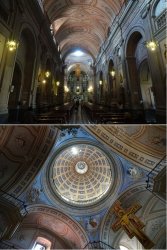



The interior of the cathedral. The floor was nicely-done, too.
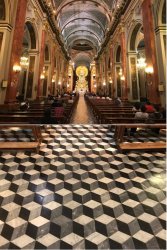
I always make a point of looking at the floor whenever I walk into a grand church because this haunts me…

The second time I went to the Sistine Chapel, that time with a friend, I said: “For God’s sake make sure you look at the floor.”!





The interior of the cathedral. The floor was nicely-done, too.

I always make a point of looking at the floor whenever I walk into a grand church because this haunts me…

The second time I went to the Sistine Chapel, that time with a friend, I said: “For God’s sake make sure you look at the floor.”!
JohnM
Enthusiast
- Joined
- Jun 7, 2006
- Posts
- 11,812
- Qantas
- LT Gold
Next day was heading out to the NW of Salta on a day trip to check out the famous La Polvorilla viaduct on the Tren a las Nubes (Train to the Clouds) railway. The railway was built for mining but is now only used for the tourist railway that runs a day-trip from Salta on Saturdays to the viaduct (4220m) and return.
The name ‘Train to the Clouds’ derives from when it was a steam train and the steam from the locomotive hung in the air, not because it rises into natural clouds. They are scarce around here in the rainshadow of the Andes.

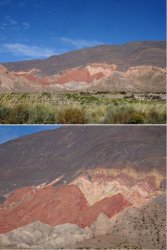


The name ‘Train to the Clouds’ derives from when it was a steam train and the steam from the locomotive hung in the air, not because it rises into natural clouds. They are scarce around here in the rainshadow of the Andes.




- Status
- Not open for further replies.
Become an AFF member!
Join Australian Frequent Flyer (AFF) for free and unlock insider tips, exclusive deals, and global meetups with 65,000+ frequent flyers.AFF members can also access our Frequent Flyer Training courses, and upgrade to Fast-track your way to expert traveller status and unlock even more exclusive discounts!

AFF forum abbreviations
Wondering about Y, J or any of the other abbreviations used on our forum?Check out our guide to common AFF acronyms & abbreviations.
Currently Active Users
- seandalgleish
- HarryTheFlyer
- asterix
- flightsonpoints
- AndrewSyd
- L2.
- http_x92
- pauldab
- cgichard
- Kangarucci
- mrsterryn
- Austman
- AIRwin
- nickjdeveril
- RSD
- wenglock.mok
- JimmyJ
- FrequentFlyer85
- DejaBrew
- Pete98765432
- jswong
- vmile
- Aeryn
- vhojm
- Chalkie
- hibbo
- am0985
- Harrison_133
- stevenaus
- qq2233
- specialgrange
- cosi
- blackcat20
- ffhound
- hutch
- Portbish
- Seat0B
- HealthyPotato
- jkbaus
- Brizz
- zig
- Intra
- I love to travel
- MELso
- Matt_H
- justinbrett
- VPS
- Up in the clouds
- muppet
- Dmac59
Total: 732 (members: 70, guests: 662)










